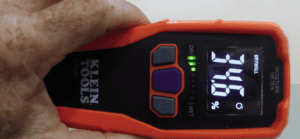Fuel tanks typically have a mechanical gauge, but water tanks can cause corrosion and waste tanks will foul the typical mechanical flat mechanism. As a result, most modern gauges are external and read right through the polyethylene or fiberglass wall. We reported on a few of these in past tests (see “Marine Holding Tank Sensors,” PS February 2008 and “Whatever Floats Your Sensor,” PS March 2008)
No sensor? You can visually check, perhaps with the aid of a flashlight, but tanks get stained pretty badly. You can tap on it or thump it with the heel of your hand, but that’s never worked for me. Often you can feel a temperature difference if you run your hand down the tank; the plastic warms up a lot faster during the day than the contents. Or you can use common technology.
External sensors are based in capacitance, or the way electrical fields are affected by the difference between air and water. Pinless moisture meters and stud finders use the very same technology, and at the suggestion of a reader, we tried them. And sure enough, our inexpensive moisture meter and stud finder was reliably able to identify the water level within ½-inch through plastic or fiberglass. Just pick a mode setting, such as “hardwood” that gives a 10-20 percent return above the water level. As you move it down, the meter will go over limit and alarm when it gets to the water level. You can also estimate the waterline from the inside of a floating fiberglass hull, which can be handy when installing or servicing a through hull.
This method will also work with fuel tanks, although most onboard fuel tanks are metal and a metal tank (water or fuel) will trigger a 100-percent reading, leaving you to guess whether there is fluid inside. One old-school solution for fuel tanks is a sight gauge, but make sure it complies with American Boat and Yacht Council Standards.

WINCH-TOP CAMERA MOUNT
The high point on our test boat’s superstructure is a cabin-top winch. To improve visibility at anchor, we built a simple mount for solar powered pathway light (see “Extra Anchor Lighting, PS October 2021). We did the same for a small camera for self portraits and action shots for Practical Sailor.
The standard octagonal winch handle hole fits a 0.70-inch (17.8 mm) square base. Teak is a good material for your base; rot-proof, hard, and easy to work. You can extend the length as needed; we chose 2.5 inches as a compromise between visibility and stability.
Simply screw-in or glue on the universal swivel top of a cheap table-top tripod.
You could also use the socket of an old winch handle. Remove the handle and mount your tripod head/light/drink holder on it. This offers the extra security of being able to lock in place. Sailing photographer David Liscio looked at various fixed and gimballed camera mounts in a previous test (see “Stabilizing Cameras and Video Cameras Underway,” PS March 2010).








































